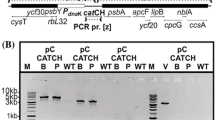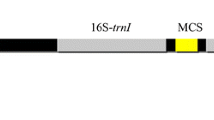Abstract
The purpose of this study was to express an antimicrobial peptide in the chloroplast to further develop the plastid engineering of H. pluvialis. Homologous targeting of the 16S-trnI/trnA-23S region and four endogenous regulatory elements, including the psbA promoter, rbcL promoter, rbcL terminator, and psbA terminator in H. pluvialis, were performed to construct a chloroplast transformation vector for H. pluvialis. The expression of codon-optimized antimicrobial peptide piscidin-4 gene (ant1) and selection marker gene (bar, biolaphos resistance gene) in the chloroplast of H. pluvialis was controlled by the rbcL promoter and psbA promoter, respectively. Upon biolistic transformation and selection with phosphinothricin, integration and expression of ant1 in the chloroplast genome were detected using polymerase chain reaction (PCR), southern blotting, and western blotting. Using this method, we successfully expressed antimicrobial peptide piscidin-4 in H. pluvialis. Hence, our results showed H. pluvialis promises as a platform for expressing recombinant proteins for biotechnological applications, which will further contribute to promoting genetic engineering improvement of this strain.



Similar content being viewed by others
References
Bauer A, Minceva M (2019) Direct extraction of astaxanthin from the microalgae Haematococcus pluvialis using liquid–liquid chromatography. RSC Adv 9:22779–22789
Bauman N, Akella S, Hann E, Morey R, Schwartz AS, Brown R, Richardson TH (2018) Next-generation sequencing of Haematococcus lacustris reveals an extremely large 1.35-megabase chloroplast genome. Genome Announc 6:e00181–e00118
Campos-Quevedo N, Rosales-Mendoza S, Paz-Maldonado LMT, Martínez-Salgado L, Guevara-Arauza JC, Soria-Guerra RE (2013) Production of milk-derived bioactive peptides as precursor chimeric proteins in chloroplasts of Chlamydomonas reinhardtii. Plant Cell Tissue Organ Cult 113:217–225
Day A, Goldschmidt-Clermont M (2011) The chloroplast transformation toolbox: selectable markers and marker removal. Plant Biotechnol J 9(5):540–553
Fan L, Vonshak A, Boussiba S (1994) Effect of temperature and irradiance on growth of Haematococcus pluvialis (chlorophyceae). J Phycol 30:829–833
Galarza JI, Gimpel JA, Rojas V, Arredondo-Vega BO, Henríquez V (2018) Over-accumulation of astaxanthin in Haematococcus pluvialis through chloroplast genetic engineering. Algal Res 31:291–297
Gan Q, Jiang J, Han X, Wang S, Lu Y (2018) Engineering the chloroplast genome of oleaginous marine microalga Nannochloropsis oceanica. Front Plant Sci 9:439–444
Gimpel JA, Hyun JS, Schoepp NG, Mayfield SP (2015) Production of recombinant proteins in microalgae at pilot greenhouse scale. Biotechnol Bioeng 112:339–345
Grevich JJ, Daniell H (2005) Chloroplast genetic engineering: recent advances and future perspectives. Crit Rev Plant Sci 24:83–107
Guo SL, Zhao XQ, Tang Y, Wan C, Alam MA, Ho SH, Bai FW, Chang JS (2013) Establishment of an efficient genetic transformation system in Scenedesmus obliquus. J Biotechnol 163:61–68
Gutierrez CL, Gimpel J, Escobar C, Marshall SH, Henríquez V (2012) Chloroplast genetic tool for the green microalgae Haematococcus pluvialis (Chlorophyceae, Volvocales). J Phycol 48:976–983
Hagen C, Siegmund S, Braune W (2002) Ultrastructural and chemical changes in the cell wall of Haematococcus pluvialis (Volvocales, Chlorophyta) during aplanospore formation. Eur J Phycol 37:217–226
Han D, Li Y, Hu Q (2013) Astaxanthin in microalgae: pathways, functions and biotechnological implications. Algae 28:131–147
Izadpanah A, Gallo RL (2005) Antimicrobial peptides. J Am Acad Dermatol 52:381–390
Kang NK, Choi GG, Kim EK, Shin SE, Jeon S, Park MS, Jeong KJ, Jeong BR, Chang YK, Yang JW (2015) Heterologous overexpression of sfCherry fluorescent protein in Nannochloropsis salina. Biotechnol Rep 8:10–15
Klein U, De-Camp JD, Bogorad L (1992) Two types of chloroplast gene promoters in Chlamydomonas reinhardtii. Proc Natl Acad Sci U S A 89:3453–3457
Klein U, Salvador ML, Bogorad L (1994) Activity of the Chlamydomonas chloroplast rbcL gene promoter is enhanced by a remote sequence element. Proc Natl Acad Sci U S A 91:10819–10823
Koo J, Park D, Kim H (2013) Expression of bovine lactoferrin N-lobe by the green alga, Chlorella vulgaris. Algae 28:379–387
Lee C, Choi YE, Yun YS (2016) A strategy for promoting astaxanthin accumulation in Haematococcus pluvialis by 1-aminocyclopropane-1-carboxylic acid application. J Biotechnol 236:120–127
Li Y, Cui D, Zhuo P, Zhang L, Sun X, Xu N (2019) A new approach to promote astaxanthin accumulation via Na2WO4 in Haematococcus pluvialis. J Oceanol Limnol 37:176–185
Lilly JW, Maul JE, Stern DB (2002) The Chlamydomonas reinhardtii organellar genomes respond transcriptionally and post-transcriptionally to abiotic stimuli. Plant Cell 14:2681–2706
Liu J (2018) Batch cultivation for astaxanthin analysis using the green microalga chlorella zofingiensis under multitrophic growth conditions. Microbial carotenoids. Springer, pp. 97-106
Ma R, Thomas-Hall SR, Chua ET, Alsenani F, Eltanahy E, Netzel ME, Netzel G, Lu Y, Schenk PM (2018) Gene expression profiling of astaxanthin and fatty acid pathways in Haematococcus pluvialis in response to different LED lighting conditions. Bioresour Technol 250:591–602
Narra M, Kota S, Velivela Y, Ellendula R, Allini VR, Abbagani S (2018) Construction of chloroplast transformation vector and its functional evaluation in Momordica charantia L. 3 Biotech 8:140–150
Ota S, Morita A, Ohnuki S, Hirata A, Sekida S, Okuda K, Ohya Y, Kawano S (2018) Carotenoid dynamics and lipid droplet containing astaxanthin in response to light in the green alga Haematococcus pluvialis. Sci Rep 8:1–10
Purton S, Szaub J, Wannathong T, Young R, Economou C (2013) Genetic engineering of algal chloroplasts: progress and prospects. Russ J Plant Physiol 60:491–499
Salger SA, Cassady KR, Reading BJ, Noga EJ (2016) A diverse family of host-defense peptides (piscidins) exhibit specialized anti-bacterial and anti-protozoal activities in fishes. PLoS One 11:e0159423
Shah M, Mahfuzur R, Liang Y, Cheng JJ, Daroch M (2016) Astaxanthin-producing green microalga Haematococcus pluvialis: from single cell to high value commercial products. Front Plant Sci 7:531–558
Specht E, Miyake-Stoner S, Mayfield S (2010) Micro-algae come of age as a platform for recombinant protein production. Biotechnol Lett 32:1373–1383
Sun Y, Liu J, Zhang X, Lin W (2008) Strain H2-419-4 of Haematococcus pluvialis induced by ethyl methanesulphonate and ultraviolet radiation. Chin J Oceanol Limnol 26:152–156
Surendhiran D, Vijay M, Razack A, Subramaniyan T, Shellomith AS, Tamilselvam K (2014) A green synthesis of antimicrobial compounds from marine microalgae Nannochloropsis oculata. J Coast Life Med 2:862–859
Teng C, Qin S, Liu J, Yu D, Liang C, Tseng C (2002) Transient expression of lacZ in bombarded unicellular green alga Haematococcus pluvialis. J Appl Phycol 14:497–500
Wannathong T, Waterhouse JC, Young RE, Economou CK, Purton S (2016) New tools for chloroplast genetic engineering allow the synthesis of human growth hormone in the green alga Chlamydomonas reinhardtii. Appl Microbiol Biotechnol 100:5467–5477
Yamano T, Fukuzawa H (2020) Transformation of the model microalga Chlamydomonas reinhardtii without cell-wall removal. Electroporation protocols. Springer, pp. 155-161
Yu J, Zhang Y, Wang Z, Li J, Zhang Y, Gong D, Gu Z (2018) Chicken (Gallus gallus) HNF1α expression in Escherichia coli and its purification. J Agric Biotechnol 26:469–475
Zhang X, Bauman N, Brown R, Richardson TH, Akella S, Hann E, Morey R, Smith DR (2019) The mitochondrial and chloroplast genomes of the green alga Haematococcus are made up of nearly identical repetitive sequences. Curr Biol 29:R736–R737
Zheng K, Wang C, Xiao M, Chen J, Li J, Hu Z (2014) Expression of bkt and bch genes from Haematococcus pluvialis in transgenic Chlamydomonas. Sci China Life Sci 57:1028–1033
Funding
The present study was supported by the National Natural Science Foundation of China (41876188, 31972815), Major Basic Research Program of Shandong Province Natural Science Foundation (ZR2018ZB0210, ZR2019ZD17), theProject of Innovation & Development of Marine Economy (HHCL201803), Key Research and Development Program of Shandong Province (Food for Special Medical Purpose) (2018YYSP016), Key Research and Development Program of Shandong Province (2017CXGC0309), the Project of Shandong Province Higher Educational Science and Technology Program (J17KA132).
Author information
Authors and Affiliations
Contributions
Chunxiao Meng and Song Qin designed the experiments. Kang Wang and Yulin Cui analyzed the data and wrote the thesis with support from Tianzhong Liu. Zhengquan Gao and Yinchu Wang performed all experiments.
Corresponding authors
Ethics declarations
Conflict of Interest
The authors declare that they have no conflict of interest.
Ethics Approval
Not applicable.
Statement of Informed Consent
Not applicable.
Code Availability
Not applicable.
Additional information
Publisher’s note
Springer Nature remains neutral with regard to jurisdictional claims in published maps and institutional affiliations.
Kang Wang and Yulin Cui are co-first authors
Rights and permissions
About this article
Cite this article
Wang, K., Cui, Y., Wang, Y. et al. Chloroplast Genetic Engineering of a Unicellular Green Alga Haematococcus pluvialis with Expression of an Antimicrobial Peptide. Mar Biotechnol 22, 572–580 (2020). https://doi.org/10.1007/s10126-020-09978-z
Received:
Accepted:
Published:
Issue Date:
DOI: https://doi.org/10.1007/s10126-020-09978-z




